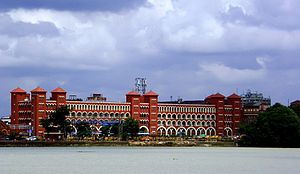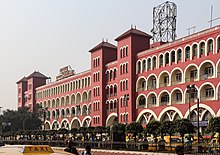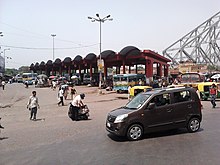Haora train station
|
Haora train station |
|
|---|---|
 View of the main building from the Hugli river
|
|
| Data | |
| Operating point type | Railway station ( local and long-distance traffic ) |
| Location in the network | Junction station |
| Design | Terminus |
| Platform tracks | 25th |
| abbreviation | HWH |
| opening | 1854 |
| Architectural data | |
| architect | Halsey Ricardo |
| location | |
| Place / district | Haora |
| Country | India |
| Coordinates | 22 ° 34 '54 " N , 88 ° 20' 32" E |
| Height ( SO ) | 12 m |
| Railway lines | |
|
|
Haora station, called Howrah Junction Railway Station in Indian Railways , in Bengali হাওড়া জংশন রেলওয়ে স্টেশন Hāoṛā Jaṃśan Reloẏe Sṭeśan , is one of the largest and oldest railway stations in India with up to 600 trains and one million passengers per day . The terminus station is located in the urban area of Haora in the state of West Bengal on the western bank of the Hugli River . On the opposite bank of the metropolis extends Calcutta and the station serves with its 25 tracks in Indian broad gauge of 23 platforms of the metropolitan area as a central railway junction.
history
The considerations for the construction of the Haora station arose in the 1850s as a starting point for a railway line along the Hugli river to Pandua via Hugli . This was preceded by the merger of the two regional railway companies East India Railway Company and Great Western Bengal Railway Company . On June 17, 1851, George Turnbull , chief engineer of the East Indian Railway Company, and his team presented the plans for a station on the banks of the Hugli to the government authorities. Although they initially - generally underestimating the development and importance of the railway - rejected the project and the expensive land purchase on the river bank necessary for its implementation, they were convinced after a revision of the plans in May 1852 and the construction of the facilities was in Written out in October . On June 18, 1853, the first locomotive started for test drives from the station and on August 15, 1854, the first official train drove on the new route to Hugli.
In the first few years the station buildings were sparse and very pragmatic in terms of the maintenance and operation of the rolling stock . The station itself was a simple building made of red brick with a corrugated iron roof and a platform. Initially, passengers even had to change the river bank to buy tickets, as there was only a railway company counter there. The facilities were gradually expanded with the rapid development of the railroad and further platforms were added in 1865 and 1895.
Rapid population growth in the region, the booming economy and the ever-growing network of railways with routes that ran from Haora to Delhi and Nagpur in the meantime led to rapidly growing passenger numbers. When a connection to Mumbai was added on April 19, 1900 with the opening of the railway bridge over the Rupnarayan river , it was decided to meet the new requirements with a completely new building.
The British architect Halsey Ricardo then designed the new building in 1901 with a sweeping, representative front facing the river, which still shapes the appearance of the station today. This offered space for six platforms in the first expansion stage, as well as for four more in a second expansion stage, with a total of 15 tracks. The building was officially opened on December 15, 1905.
In 1969 Haora was integrated into the network of the prestigious Rajdhani night trains and the first train of this type left the station on March 3rd of that year. (See also: Howrah – New Delhi Rajdhani Express .)
In the 1980s it became necessary to expand the station again as the population of Calcutta alone had grown to over 3.3 million people. So by 1984 another terminal with eight new platforms was added on the south side of the station, supplemented by an additional arrival building parallel to the bank line. This is called Yatri Niwas and with its red color scheme, sweeping arches and enclosing towers at the corners, it matched the existing building ensemble.
Further extensions and modifications were added in 1992 and 2009. The total number of platforms increased to 19 in 1992, and after the turn of the millennium to 23 with the current 25 tracks.
AK-6 steam locomotive from 1914 on display in front of Haora station as it was used on the Howrah to Pandua route
construction
Station building
The station is the headquarters of the Indian Eastern Railway, a regional company of Indian Railways, and in the main buildings along the bank, in addition to the facilities for passenger traffic and the supply of travelers, the railway company's offices and communication facilities are located. These are mainly located on the upper floors.
The station has 23 platforms for rail operations. Numbers 1 to 16 are in the old complex, which was completed in 1905 and is known as "Terminal 1". This serves the local and long-distance traffic of the Eastern Railway and the local trains of the South Eastern Railway. Platforms 17 to 23 are located in the building erected in 1984 on the south side. This is called "Terminal 2" and from here the long-distance trains of the South Eastern start.
There are large, covered waiting areas for travelers between the two main buildings and between the platforms that were added later. For transit passengers with a longer stay, there is a hotel in Yatri Niwas (Terminal 2) with a dormitory as well as single and double rooms. This is complemented by an air-conditioned lounge area with a balcony view of the Calcutta skyline and the nearby Rabindra Setu bridge over the Hugli .
environment
To the east, Station Road runs along the bank, to which the ramp of the Rabindra Setu Bridge, built in 1943, connects on the north side, as well as a bus station. To the west of the track system, an elevated road crosses the area with the Bankim Setu , from which two ramps lead to access roads to the station. These end in the north between platforms 8 and 9 and in the south between platforms 21 and 22.
A metro station is currently being built within the platform area in front of Terminal 2 (platforms 14 to 17) and a 130 m long pedestrian bridge will connect the remaining platforms. It is planned that Line 2 of the Kolkata Metro will be moved to under the station. When the work is completed at the end of 2020, it will be the deepest subway station in India with a depth of 30 m.
Maintenance and repair facilities follow in the south. The end of the station area in this direction has been a regional railway museum of the Eastern Railway since 2005.
Vehicle maintenance
Two locomotive sheds belong to the station area . The system for diesel locomotives can provide shelter for up to 84 locomotives. The area for electric locomotives can hold 96 units. Among other things, locomotives of the types WAP-4, WAP-5 and WAP-7 are serviced here. There is also a hall for the accommodation and maintenance of up to 20 railcars .
Transport links
The Eastern Railway operates local trains from Haora - among others - to Belur Math , Tarakeswar , Arambagh , Goghat , Katwa, Bandel , Sheoraphuli , Bardhaman and Serampore . There are also post and express connections to central, north and north-east India.
The South Eastern Railway runs local services to Amta , Mecheda , Panskura , Haldia , Tamluk , Medinipur and Kharagpur . In long-distance traffic, there is a connection to West and South India, including the Great Indian Peninsula Railway , which leads to Mumbai and Chennai . From the point of view of the route network, the station serves as the starting point for the main routes to Delhi , Mumbai, Chennai and Guwahati .
Upon completion of the subway station, Line Two of the Kolkata Metro will stop under the station. There is also a central bus station in the north of the station and various bus stops around the site. There is a ferry dock on the shore.
Until 1992 there was also a tram connection over the Rabindra Setu Bridge to Calcutta. However, after the load capacity was in question due to the very heavy traffic, tram traffic was discontinued.
See also
- Fairy Queen , the oldest operational steam locomotive that was on display in front of the station until 1943.
Web links
- Historical Perspective - The First Journey. Eastern Railway, September 11, 2018, archived from the original on December 28, 2018 (English, outline of the history of the Indian Eastern Railway with Haora station as its headquarters).
- Flyer from the local railway museum
Individual evidence
- ↑ The daily commute at Howrah station is on a biblical scale as half a million passengers pour off trains. mirror.co.uk, accessed April 15, 2020 .
- ↑ Passengers run riot in Howrah. telegraphindia.com, accessed April 15, 2020 .
- ↑ a b c Howrah Railway Junction Station, Howrah, 1854. puronokolkata.com, accessed April 15, 2020 .
- ↑ George Turnbull, C. E: Memoirs, S: 110, 121-127 . privately published, 1893.
- ↑ a b c HOWRAH STATION: Detailed information regarding available Passenger Amenities. indianrailways.gov, November 29, 2019, accessed April 15, 2020 .
- ↑ A bridge over Roopnarayan. Telegraph India, online edition, accessed April 16, 2020 .
- ^ Rule Britannia. tripod.com, accessed April 15, 2020 .
- ^ Howrah Station is veritably the heartbeat of Kolkata. thehindubusinessline.com, July 6, 2011, accessed April 15, 2020 .
- ↑ Howrah-New Delhi Rajdhani Express completes glorious 50yrs in passenger service. uniindia.com, March 4, 2019, accessed April 15, 2020 .
- ↑ EASTERN RAILWAY - A BRIEF PROFILE. er.indianrailways.gov.in, March 18, 2020, accessed April 16, 2020 .
- ↑ Kolkata Metro's Howrah station by Indian Railways is India's deepest subway station! financialexpress.com, August 19, 2019, accessed April 16, 2020 .
- ^ India's deepest Metro station comes up 30m below Howrah railway station. indiatimes.com, August 13, 2019, accessed April 16, 2020 .
- ↑ Rail Museum2.pdf. (PDF) er.indianrailways.gov.in, accessed on April 16, 2020 .
- ^ Organization Chart of Rolling Stock. er.indianrailways.gov.in, February 18, 2020, accessed on April 16, 2020 .
- ↑ Request for Empanelment (RFE) for Preparation of Station Development Plan for railways stations under Indian Railways, Apendix-I, p. 17. (PDF) AECom, accessed on April 16, 2020 .
- ↑ Hosanna to Howrah Bridge! ( Memento from November 17, 2011 in the Internet Archive )







